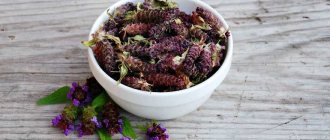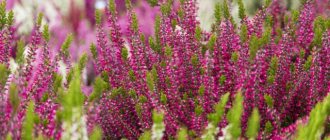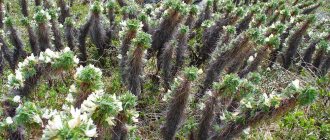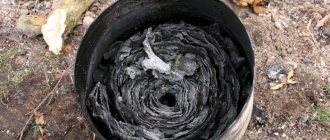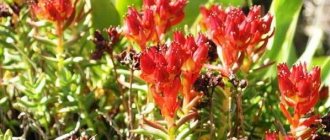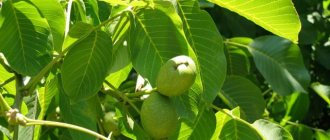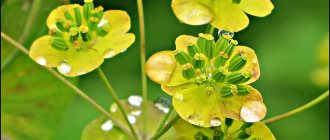What it looks like and where it grows
Goldenrod is a perennial herbaceous plant belonging to the Asteraceae family. The name is translated from Latin as “golden rod” or “strong”, “healthy”. The plant has an erect stem, the height of which reaches 100 cm. A distinctive feature of the plant is the root that goes deep into the ground. The color of the stem bark can be either crimson or emerald. The leaf part has an ovoid or oval shape. The lower leaves are longer than the upper ones.
During the flowering period, goldenrod is covered with yellow flowers that have a delicate, pleasant aroma. Budding begins at the end of summer and continues until October. In total, there are about 80 varieties of goldenrod, but only 20 of them are widespread in gardening. Common goldenrod is found in Western Siberia, the Far East and the Caucasus.
The golden rod is considered an asteraceous plant.
Attention! Golden rod loves regular watering and feeding with nutrient mixtures.
Description and features of goldenrod
There are more than 80 species of plants from the Northern Hemisphere, the main part grows in America and Canada. The height of the bush varies, there are low-growing varieties and giants up to 1.5 meters. The shoots are branched, some begin to branch only at the level of inflorescences, their length is from 20 to 35 cm, the color is yellow with a lemon or orange tint. The leaves are wedge-shaped, with jagged edges resembling a saw.
Small flowers are collected in baskets; they cling to the flower shoot on one, two sides or all around. Depending on the species, they bloom from mid-summer to late autumn. They produce seed pods up to 4 mm long, cylindrical in shape.
Goldenrod is characterized by active reproduction and displaces other species from its range. Up to 100 thousand seeds with good survival rate grow annually. It has medicinal properties and is used in medicine, pharmacology, and cosmetology.
Chemical composition
The medicinal properties of the goldenrod plant are due to its rich composition. In addition, it is considered not fully studied. The highest concentration of useful components is contained in the stem. The rhizome of the plant is a rich source of inulin, which is a prebiotic from the group of polysaccharides. Goldenrod fruits contain a huge amount of fatty oils. And the inflorescences, in turn, are famous for their content of monosaccharides and carbohydrates. Goldenrod contains the following substances:
- alkaloids;
- lipophilic elements;
- chlorophyll;
- resins;
- coumarins;
- essential oils;
- diterpenoids;
- organic phenolcarboxylic acids;
- tannins;
- ascorbic acid;
- saponins;
- group B nutrients;
- Sahara.
Compound
The healing properties of the golden rod are explained by its rich composition. The herb contains:
- tannins - they give the plant a bitter taste, have antibacterial and anti-inflammatory properties, and affect faster healing of wounds;
- ascorbic acid - in other words, vitamin C, which has antioxidant properties; regenerates tissue during wound healing, lowers blood sugar levels and improves calcium absorption;
- quercetin is one of the flavonoids that has an effect on reducing the risk of cardiovascular diseases and also helps in improving immunity;
- essential oils - they have a positive effect on the body, reduce menstrual pain, rheumatism, prevent skin aging and help fight acne;
- mineral salts - their presence is extremely important for the body, because deficiencies can lead to symptoms such as diarrhea, nausea, vomiting or excessive sweating.
In addition, the plant contains alkaloids, carotenoids and glycosides, which affect the proper functioning of the body.
Medicinal properties of the herb goldenrod (golden rod)
Due to its beneficial properties, goldenrod is widely used in alternative medicine. It began to be used more than 300 years ago. The main advantage of the plant is its natural composition, which significantly reduces the likelihood of side effects. In alternative medicine, golden rod is primarily considered as a diuretic. It has a pronounced diuretic effect.
Due to the rich content of flavonoids, the plant eliminates diseases of capillaries and blood vessels. And its antifungal effect makes it effective against candidiasis. The beneficial properties of goldenrod include the following:
- diuretic effect;
- wound healing effect;
- antibacterial properties;
- antiviral effect;
- elimination of swelling;
- antispasmodic effect;
- stopping bleeding;
- antifungal effect;
- anti-inflammatory effect;
- prevention of oncological processes;
- strengthening the immune system;
- choleretic effect.
For women
The plant is of particular value for the female hormonal system. It fights genitourinary diseases by balancing hormone levels in the body. Anti-inflammatory properties allow the plant to be used in the fight against certain gynecological diseases. In addition, goldenrod has a positive effect on egg quality, which increases the chances of a successful pregnancy. According to many years of research, goldenrod treats the following diseases:
- adnexitis;
- cystic formations;
- candidiasis;
- erosion;
- vaginitis;
- bartholinitis.
To achieve the necessary therapeutic effect, infusions and decoctions of plants are used as a solution for douching. At the same time, internal administration of the drug is practiced. This helps improve the effectiveness of therapy.
The plant is considered resistant to pesticides
For men
Goldenrod can be used to treat specifically male diseases. It is effective against diseases of the reproductive system. It normalizes hormonal levels, helping to stabilize spermatogenesis. The positive effect of the plant on blood vessels helps to cope with congestion in the pelvis. This provides relief from impotence and prostate adenoma. After treatment with the golden rod, the quality of seminal fluid improves, which is reflected in future offspring.
It should be remembered that goldenrod has not only medicinal properties, but also contraindications for men. These include kidney diseases and disorders of the circulatory system.
Advice! Men can use pharmaceutical preparations containing golden rod extract.
During pregnancy
The ban on the use of goldenrod during pregnancy applies only to the first trimester. During this period, the fetus is less resistant to the influence of environmental factors. Carrying out herbal medicine may affect its viability.
In subsequent trimesters, the use of goldenrod-based medicines is not prohibited. The exception is the internal use of tinctures and decoctions. They are used externally only. An indication for their use may be back pain. If they appear, rub the lower back with an alcoholic tincture of goldenrod. It can also be used to heal mouth ulcers. In this case, the product is used for rinsing.
After giving birth, you should completely stop using goldenrod. Its components can pass into breast milk and have a toxic effect on the baby. A dose of golden rod intended for an adult can significantly harm a child.
Application area
The beneficial properties of Canadian goldenrod allow it to be used to treat many diseases. After all, the plant has a pronounced anti-inflammatory and choleretic, diuretic and antibacterial, astringent and expectorant, analgesic and hypoglycemic, restorative and wound-healing effect (see photo of Canadian goldenrod below).
The medicinal properties of the plant, namely its powerful antibacterial effect, make it an excellent addition to drug therapy for a disease such as pulmonary tuberculosis. In addition, the medicinal herb has an expectorant and antitussive effect, helping to clear the lungs of phlegm in them, which provokes coughing attacks. Doctors note that after including the plant in the course of therapy, the patient’s condition improved significantly.
The plant provides invaluable assistance in the treatment of bronchitis, as well as bronchial asthma. This occurs not only due to its antitussive properties, but also due to its powerful anti-inflammatory, antifungal and antibacterial effects.
Preparations containing Canadian goldenrod help with inflammatory processes in the bile ducts and gallbladder, as well as with bile stagnation. Pain syndromes in such cases are relieved already on the first day of treatment.
The plant is used to provide a diuretic effect when it is necessary to remove sand from the kidneys, as well as to relieve swelling. Moreover, preparations containing Canadian goldenrod improve the patient’s condition even in cases where he has swelling of the internal organs or even the brain. The healing herb actively removes fluid from the body in the shortest possible time, eliminating its excess.
Canadian goldenrod is also used for liver pathologies. In this case, it is also able to exhibit a pronounced therapeutic effect. At the same time, inflammation is relieved, the liver is cleansed of toxins, and self-healing processes of the affected cells are launched.
Use of goldenrod in folk medicine
Goldenrod helps against many diseases and pathological processes. For this reason, it is widely used in homeopathy and alternative medicine. Decoctions, infusions and alcohol tinctures are prepared from the plant. The latter are often used as a compress and to cauterize problem areas. The flavonoid complex of goldenrod provides powerful hypoazotemic and diuretic effects. It restores water-salt metabolism and equalizes urine pH. That is why goldenrod is often used to eliminate urate and oxalate stones.
Goldenrod infusion
Goldenrod infusion is prepared at the rate of: 1 tbsp. l. dry mixture per 200 ml of water. The leaves are poured with liquid overnight and filtered in the morning. The finished medicine is drunk in small sips throughout the day. Take 20-30 minutes before meals. This treatment allows you to get rid of cough, normalize kidney function and strengthen the immune system. The duration of therapy will vary in each individual case.
It is not advisable to increase the strength of the drink
Important! The germination rate of goldenrod is 95%, which is why it is considered an invasive plant.
Goldenrod decoction
For the decoction, use the same ratio of components as for the infusion. But the leaf part is filled with hot water at a temperature of at least 90 °C. Then the product is brought to a boil in a water bath. After removing from heat, let it sit for 3 hours. Before use, the decoction is filtered. It should be taken 30 ml 3 times a day.
A package of golden rod can be purchased at your nearest pharmacy
Alcohol tincture of goldenrod
For kidney diseases, an alcoholic tincture of goldenrod is often used. It is prepared from the young stems of the plant. They are crushed and filled with vodka. For 500 ml of alcohol base you will need 7 tbsp. l. raw materials. The plant is infused in a glass container with a sealed lid. The duration of infusion is 3 weeks. After the specified time, the tincture is filtered and poured into another container.
Take 1 tsp. 1 per day. The tincture is first diluted with a small amount of clean water. It is recommended to take it internally to get rid of inflammatory processes, kidney diseases and bile stagnation. For external use, compresses with goldenrod tincture are used.
The tincture should be stored in a dark glass bottle
Goldenrod tea
To prepare medicinal tea: 1 tbsp. l. The stems of the plant are poured with 300 ml of hot water. After 3-5 minutes, the drink is poured into cups. It helps prevent diseases of the urinary system and strengthen the immune system. Drinking goldenrod tea regularly reduces the likelihood of kidney stones.
We recommend reading: Mint tea: beneficial properties and contraindications, how to make
Plants can be mixed with other herbs to make tea
Bath decoction with goldenrod
Baths with goldenrod are recommended for people suffering from tuberculosis and skin diseases. 50 g of dry mixture should be added to 10 liters of water. Place the container on the fire and bring to a boil. Then the product is infused for 2 hours. After the specified time, it is added to the bath, preheated. The bathing procedure lasts at least 20 minutes. It is recommended to do it at least once a week.
The golden rod decoction has a pleasant herbaceous taste.
Compresses
For compresses, use alcohol tincture or oil. The first remedy is prepared for 3 weeks in a dark place. To prepare the oil extract, 2-3 tbsp. l. goldenrod inflorescences are poured with a mixture of olive and sea buckthorn oils. A gauze swab is soaked in the resulting substance, and then applied to the problem area. After 15 minutes, the compress is removed. The procedure is carried out twice a day.
Compress helps relieve joint pain
Goldenrod ointment
If it is necessary to treat skin diseases, you can use goldenrod ointment. It will require 4 tbsp. l. dried inflorescences and 100 g of pork fat. First, the fat is melted in a water bath, after which it is mixed with the main component. The mixture is thoroughly boiled for half an hour. The finished product is filtered and used for its intended purpose. The ointment helps to cope with focal baldness, local peeling of the skin and fungal diseases.
Goldenrod ointment should be stored in the refrigerator
Ornamental species and varieties of goldenrod
In total, there are about 120 species in the genus, the vast majority of them are wild perennials not cultivated by humans. Only a few solidagos are adapted for decorative purposes.
Common goldenrod (lat. Solidago virgaurea) is sometimes called European solidago. It is widespread in most European countries, as well as in North Africa, North, Central and South-West Asia. The plant is found both wild and as a garden crop.
It is a tall (about 1 m) herbaceous perennial with a powerful branched rhizome, erect shoots, simple or slightly branched in the upper part, and elongated lanceolate leaves. In mid- or late summer (July-August), racemose or paniculate inflorescences appear in the upper part of the stems, consisting of a large number of small golden-yellow flowers.
There are a large number of varieties and subspecies of common goldenrod, some of which have been introduced into cultivation:
- Small (subsp. minuta) – differs, as the name implies, in its compact size.
- Daurian (subsp. dahurica) is a Far Eastern variety of goldenrod.
- Alpine (subsp. alpestris) - a plant native to the alpine foothills.
- Hairy carpa (subsp. leiocarpa) is a miniature variety with bright yellow umbrella inflorescences.
The most famous varieties are the following:
- "Praecox" (Prekoks) is an early flowering variety.
- "Paleface" (Pale-faced) is a plant with light, creamy yellow inflorescences.
- "Variegata" - variegated goldenrod.
Z. lesser, Z. alpine, Z. hairy
Goldenrod (lat. Solidago altissima) is a species originating from the North American continent (most of the USA, southern Canada, northern Mexico).
It is distinguished by its large (from 1 to 2 m) size, erect, slightly pubescent stems, and leaves alternately located along the entire length of the shoot. The leaf shape is lanceolate, the edges of the leaf blade are decorated with small teeth. The inflorescences that bloom at the end of summer are very impressive - small lemon-yellow single flowers are collected in elongated racemes, and these, in turn, are collected in large panicles. The size of an individual paniculate inflorescence can reach 35 cm in length.
The bicolor goldenrod (lat. Solidago bicolor) is distinguished by an unusual shade of inflorescences for the genus. The petals are not yellow like other goldenrods, but creamy white. The plant has thin, hard, slightly pubescent stems, large oval-lanceolate leaves, and the inflorescences, unlike other species, are collected not at the end of the shoot, but in the axils of the leaves.
The bicolor goldenrod is native to the eastern and northern United States, as well as Canada. In our country, this species is still very rare and is found only in some nurseries.
Blue-grey goldenrod (Solidago caesia), also known as forest goldenrod, is another North American species. The name of the plant is associated with the unusual emerald hue of the narrow leaves and the purple-burgundy color of the long lodging shoots. In summer, many small bright yellow inflorescences appear along the stem, which look great against the background of bluish foliage. The plant is very elegant and decorative.
Z. highest, Z. two-color, W. bluish-gray
Canadian goldenrod (lat. Solidago canadensis) has a classic appearance for this plant: tall (up to 1.5 m) strong stems, elongated lanceolate bright green leaves and large golden panicle inflorescences at the ends of the shoots.
Initially, Canadian goldenrod grew only in North America, but over time, thanks to human intervention, it spread widely throughout Europe, Siberia and Southeast Asia. The high viability of the plant allows it to survive even in extreme conditions. For example, after fires or other natural disasters, goldenrod is the first to recover. This property has made Solidago an invasive species.
[!] Plants that have spread as a result of human action, displacing local species and occupying large areas, are called invasive.
China and Japan were particularly hard hit by the intense invasion of Canadian solidago, where the plant destroyed many orange plantations and rice fields.
Rigid goldenrod (lat. Solidago rigida) is a compact species with erect stems branching in the upper part, elongated leaves, some of which are collected in a basal rosette, and the other part is alternately located on the stem, and numerous golden-yellow inflorescences. This beautifully flowering perennial is often found both in the wild and in cultivation.
Shorty's goldenrod (lat. Solidago shortii) differs from others in its rather modest (up to 90 cm) size and graceful drooping stems. In September, numerous golden-yellow flowers appear at the ends of the shoots, collected in loose inflorescences.
This species is quite rare and is found naturally only in a few North American states. Economic activity has led to the almost complete disappearance of the wild-growing Solidago Shorty, and now the plant is under enhanced protection by environmentalists.
Z. Canadian, Z. Hard, Z. Shorty
Hybrid goldenrod (lat. Solidago x hybrida) is a name that unites a group of artificially bred solidagos that cannot be classified as specific species. The basis for selection was Canadian and common goldenrod.
The most popular decorative varieties of hybrid goldenrod include:
- "Fireworks" (Salute) is a slow-growing, non-aggressive variety with numerous golden-yellow inflorescences.
- "Goldenmosa" (Goldenmosa) is a compact (no more than 75 cm) perennial, decorated with cone-shaped bright yellow inflorescences.
Z. "Fireworks", Z. "Goldenmosa"
Goldenrod in landscape design
This beautifully flowering perennial looks unusually impressive in the garden and is capable of performing several functions at once.
Tall varieties and species can serve as a background in a complex multi-faceted flowerbed, act as a large tapeworm on an open lawn or clearing, and also block unsightly outbuildings. The dimensions of the plant and the density of its greenery can completely hide ugly old walls, compost heaps, fences, etc.
If we talk about plant partners suitable for goldenrod, it is better to choose them from perennial representatives of the aster family. Plants of the same family are easier to maintain, because... they need identical conditions, and the diversity of asteraceae is unusually large. You can choose beautifully flowering crops to match goldenrod (heliopsis, gaillardia, ratibida), or you can play on the contrast by planting flowers in cool colors next to solidago (perennial aster, pyrethrum).
Lower-growing goldenrods can be planted in dense groups as borders along paths or as fillers in low beds in open spaces. There are few compact varieties of Solidago, but if you are lucky enough to find one on sale, be sure to experiment with this colorful plant.
Beneficial properties and contraindications of goldenrod honey
Goldenrod honey is considered one of the most common folk remedies. It is classified as a rare variety, distinguished by a host of useful qualities. The product is dark yellow in color and has a thick consistency. Most often, it is used to treat burns, colitis, insomnia and various skin lesions. The medicinal properties of goldenrod honey include the following:
- strengthening the heart muscle;
- increased visual acuity;
- treatment of colds;
- kidney cleansing;
- accelerating the skin regeneration process;
- strengthening the immune system.
The main contraindication to the use of golden rod honey is individual intolerance. Bee products are quite strong allergens, so they should be used with extreme caution. It is also unacceptable for people with diabetes to use honey.
Comment! Before combining the plant with medications, you should consult your doctor.
Making goldenrod tea
Place about a teaspoon of dried inflorescences in a cup of warm water, then place it on the stove and wait for the mixture to boil. Let it brew a little, no more than three minutes. Use with caution; three cups per day is considered the limit.
Medicinal properties of goldenrod in teas:
- relieves pain and inflammation in the throat;
- exhibits antioxidant properties;
- reduces acidity in the body;
- promotes the removal of phlegm from the lungs;
- is a preventative measure for inflammation and various colds;
- It is better to limit yourself to one cup of tea a day for people suffering from any heart pathologies.
We recommend reading: Viral diarrhea: causes, symptoms and treatment
This drink has a pleasant taste and gives a good aroma.
Collection and storage of goldenrod
It is recommended to collect the plant at the beginning of flowering. It falls in the first days of August. It is not necessary to pick off the entire above-ground part; the inflorescences are enough. The collected raw materials are distributed into several bundles and sent to dry in this form. They are hung in a dark place with good ventilation.
Harvested raw materials are stored in paper bags or fabric bags. The optimal storage location is a dark room with a temperature not exceeding 30 °C. If all conditions are met, the remedy retains its properties for 2 years.
Application in landscape design
Canadian goldenrod was introduced into culture back in the 17th century. Since then it has been used in landscape design. It is grown:
- in a group of plants;
- as a monoculture in a flowerbed;
- for decoration of garden buildings
- along the perimeter of the site as a green fence;
- along paths as a border crop.
Tall varieties of goldenrod are used for fencing, and dwarf varieties are used for borders.
Solidago canada is also cultivated for cut bouquets. Blooming goldenrod lends itself well to drying and can be used as an element for dry compositions.
Side effects of goldenrod and contraindications
Before using goldenrod herb, you need to study its contraindications. This will eliminate possible consequences. Particular caution should be exercised by people prone to allergic reactions. Other contraindications for the drug include:
- bilateral kidney inflammation;
- age less than 15 years;
- acute form of nephrological diseases;
- pregnancy and breastfeeding;
- heart failure;
- the presence of kidney stones;
- liver diseases.
The plant contains toxic components. If they enter the body in excessive quantities, they can cause poisoning. Possible side symptoms include:
- increased sweating;
- gagging;
- stool disorder;
- cardiopalmus;
- dizziness;
- tremor in the limbs;
- insomnia.
Planting and care
Being a tenacious weed, Canadian goldenrod does not require special growing conditions. It is enough to choose a suitable place, without particularly worrying about lighting. Subsequently, it is necessary to control the expansion of the plant.
Recommended timing
The timing of planting Canadian solidago depends on the chosen method of propagation. Seeds are sown immediately under the open sky in early spring. Since they are small, the sprouts that emerge later are thinned out.
Green cuttings are cut after they have reached almost full growth. Planting material is prepared in the same way as for any other plant. But cuttings are the most inconvenient way to propagate Solidago canadensis. The plant takes root best in conditions of artificial fog. It is irrational to buy an installation for the sake of one flower bed. Therefore, it is better to use division of the rhizomes of Canadian goldenrod.
This procedure is best carried out in late autumn, but before the onset of frost. For the winter, the aboveground part of the Canadian goldenrod is cut off. At this time, you can dig up the plants and divide them.
Comment! Varietal varieties of Solidago canadensis are propagated by dividing the rhizomes. As a last resort, cuttings.
Site selection and preparation
The Canadian species of goldenrod prefers fertile soils, but survives well in poor soils. The same goes for lighting: it prefers sunny places, but can also grow in light shade.
Loves mineral fertilizers: potassium salt and superphosphate. If you need luxurious flowers, when preparing the soil you need to immediately add the necessary fertilizers.
The site must be chosen so that during floods and autumn rains the groundwater is below the roots of the goldenrod. If there is excessive moisture, the root system may rot. This point must be taken into account when watering. During flowering, the plant needs more water, but it is important not to overdo it.
Landing algorithm
Seeds are sown in early spring on loosened soil without prior preparation. There is no need to bury them, as they are very small. It is enough to lightly dust the achenes with soil and carefully water them from a watering can. When the sprouts grow, they are thinned out so that there is a distance of 20-30 cm between them.
When planting divided rhizomes, the rules are the same as for other perennial herbaceous plants. That is, after preparing the soil, the seedling is placed in a hole and covered with earth up to the root collar. If planting is carried out in the fall, take into account the weather forecast. Goldenrod must be planted so that it has time to settle in a new place before the onset of frost.
The root system of the Canadian species Solidago is very powerful and difficult to remove from the ground.
Comment! If necessary, you can divide and replant the rhizomes in early spring.
Features of cultivation
Caring for Canadian goldenrod, in fact, contains only two requirements: controlling the growth and pruning the stems before wintering. The plant is very winter-hardy and does not require special shelter for the winter. But the stems are cut at a height of 15 cm above ground level or lower.
Every 3-4 years, goldenrod must be dug up and the rhizomes divided. Solidago canadensis grows very strongly. If you do not regularly divide the plant, the plant will fill the entire area.
During the flowering period, more intensive watering is carried out than at any other time. This is where goldenrod care ends.
Pests and diseases
The Canadian newcomer in Eurasia has no natural enemies or diseases. This fact also contributes to the rapid spread of the weed throughout the surrounding area. But for a gardener, this circumstance can be a plus: Canadian solidago can cope with pathogenic microorganisms in the soil on its own, and there are no insects that eat it in Russia.
Varieties of goldenrod
In nature, there are several types of golden rod: tall, Daurian, hybrid, ordinary, Canadian. They will all differ in their properties. Common goldenrod has the largest range of healing properties. Its medicinal properties are very strong:
- Choleretic.
- Expectorant.
- Anti-rotten.
- Hemostatic.
- Having a positive effect on the immune system.
With the help of goldenrod, you can cure diseases such as rheumatism, neurasthenia, tuberculosis, hepatitis, dermatitis, and inflammation of the bladder. Canadian goldenrod has a very strong diuretic effect. Herbalists often use its medicinal properties. Quite often, this plant is used to treat the genitourinary system, as well as urolithiasis.
Limit use only in cases of phosphate stones that are located in the kidneys. This is because phosphates and some plant chemicals increase the pH of urine. With the help of the plant, you can have an antimicrobial effect and use it in cases where there is a very long-term illness. It is worth noting that in Russia this plant is well known under a different name - mimosa.
Read more: What is spirulina and how is it useful: beneficial properties and how to take it

